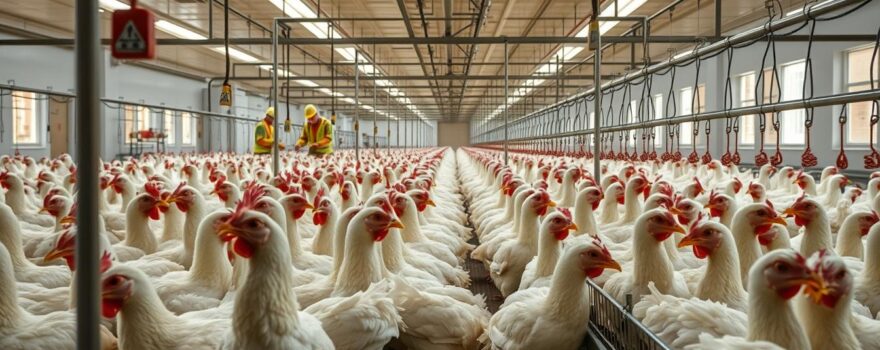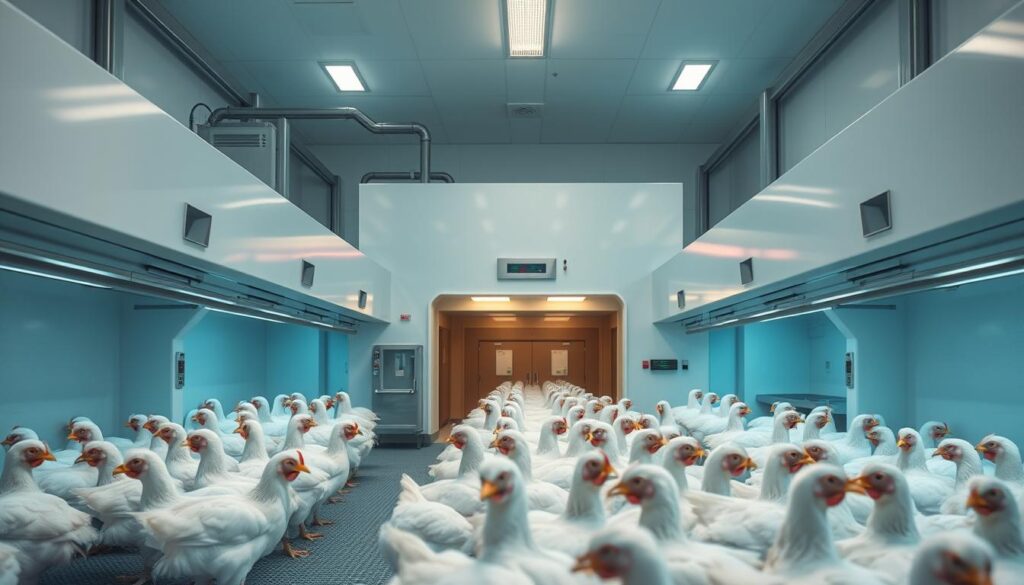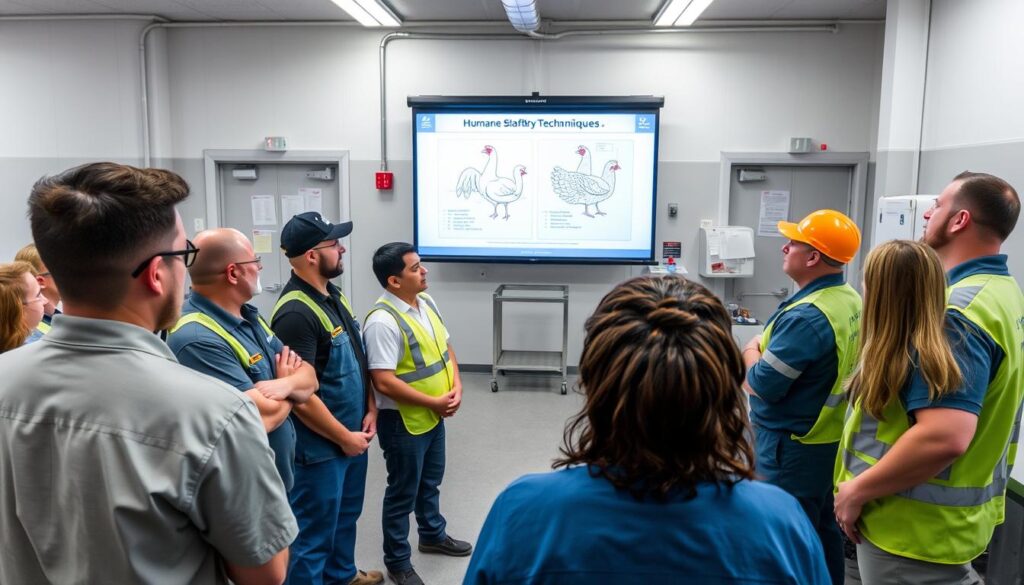
Slaughter practices in the global food supply chains have recently caught a lot of attention. This is true for both food businesses and consumers. This article talks about the humane slaughter of broiler chickens. It covers the main methods used in the United States and suggests corporate animal welfare policies.
Key Takeaways
- The Importance of Humane Slaughter Practices in Broiler Chicken Processing
- Understanding animal welfare and ethical treatment in the poultry industry standards
- Exploring the use of controlled atmosphere stunning as a more humane alternative to conventional methods
- Emphasizing the role of employee training and standard operating procedures in ensuring humane slaughter
- Promoting consumer awareness and regulatory compliance for sustainable poultry processing practices
Introduction to Humane Slaughter in Broiler Chicken Processing
The poultry industry is key in the global food supply, offering a big source of protein. But, the way broiler chickens are slaughtered has faced more scrutiny lately. This is because both consumers and the industry see the need for humane treatment of these animals. This section gives an overview of the main slaughter methods and why humane practices are important.
Overview of Slaughter Practices in the Poultry Industry
The main ways to slaughter broiler chickens are electrical waterbath stunning, controlled atmosphere stunning, and percussive stunning. Electrical waterbath stunning is used worldwide, but there are animal welfare concerns. Controlled atmosphere stunning, especially with carbon dioxide, is becoming more popular because it’s seen as less stressful for the birds. Inert gas systems and low atmospheric pressure stunning are also being explored as humane options.
The Importance of Humane Slaughter Practices in Broiler Chicken Processing
Ensuring humane slaughter of broiler chickens is not just a moral issue but also affects the food supply chain. By using best practices in slaughter, training staff, and monitoring animal welfare, the industry can improve animal treatment. This also boosts consumer trust and follows regulations. Prioritizing humane slaughter shows the poultry industry’s dedication to responsible and sustainable practices, benefiting both animals and the community.
Electrical Waterbath Stunning: The Conventional Method
The poultry industry in the United States mainly uses electrical waterbath stunning to make broiler chickens unconscious before slaughter. Birds are taken out of their crates and hung upside down on a moving line. As they go through an electrified waterbath, the electricity goes through their bodies and up the metal shackles, aiming to stop their heart and make them unconscious.
How Electrical Waterbath Stunning Works
Studies show that a frequency of 750 Hz and an average current intensity of 200 mA per bird in the water bath work best. The Regulation (EC) N.1099/2009 sets minimum current levels for different frequencies to ensure effective stunning. It also suggests a minimum exposure time of four seconds per bird.
Welfare Concerns with Electrical Waterbath Stunning
But, there are serious welfare concerns with electrical waterbath systems. Handling and turning the birds can cause a lot of pain and stress. The stunning process may not always be consistent, leading to meat quality issues and the chance of birds waking up before they are killed.
The EFSA Scientific Opinion (EFSA, 2012) says the birds should be unconscious for at least 45 seconds from the start of stunning to death by bleeding out. But, this is not always the case in commercial settings.
“An effective water bath stunning in commercial slaughterhouses relies on various indicators to confirm unconsciousness, such as the corneal reflex, with up to 30% of corneal reflexes considered acceptable post-stunning.”
The welfare aspects of stunning systems in place during the killing of commercial animal species were extensively assessed in 2004 by the EFSA. A more recent study in 2012 by the European Commission focused on various stunning methods for poultry in the food chain industry.
Controlled Atmosphere Stunning: A More Humane Alternative
The poultry industry is changing, and controlled atmosphere (gas) systems are becoming a better choice. These stun-kill systems use a mix of gases in a closed space. This way, birds stay in their crates and don’t need to be handled again.
These systems are better for animal welfare. They keep birds in their crates, reducing stress and discomfort. They also prevent birds from waking up before they are properly bled, a problem with old methods.
More and more, controlled atmosphere stunning is being used. In 2013, it was used for 71% of poultry in Great Britain. Across Europe, 20% of broiler chickens, 7% of laying hens, and 24% of turkeys are now stunned this way.
| Country | Percentage of Broiler Chickens Slaughtered Using Controlled Atmosphere Systems |
|---|---|
| Great Britain | 71% |
| European Union | 20% |
The rise in controlled atmosphere stunning shows the industry’s focus on animal welfare. As plants aim to improve, research and experts keep checking these systems. They look at how they affect animal welfare and meat quality.
“In the UK, it is a legal requirement that birds must be killed in the system rather than just stunned.”
Carbon Dioxide Stunning Systems
Carbon dioxide is often used to stun broiler chickens before they are slaughtered. There are two main ways to do this: multi-phase and single-phase CO2 stunning.
Multi-Phase and Single-Phase CO2 Systems
Multi-phase systems use a mix of gases, including up to 40% carbon dioxide. This makes the birds stunned. Then, they are exposed to even more CO2 (>55%) to kill them. On the other hand, single-phase systems are not advised. They can cause more stress and harm to the birds.
Another method combines carbon dioxide (up to 30%) with other gases. This mix is less stressful for the birds. It makes the stunning process more humane.
| Parameter | Multi-Phase CO2 Systems | Single-Phase CO2 Systems |
|---|---|---|
| CO2 Concentration | Up to 40% in initial phase, followed by >55% | Up to 30% |
| Bird Agitation | Reduced | More severe |
| Potential for Injury | Lower | Higher |
| Recommendation | Preferred | Not recommended |
Advantages and Disadvantages of CO2 Stunning
CO2 stunning has its benefits. It makes birds unconscious and reduces their stress. But, it’s crucial to control the CO2 levels carefully. Wrong use can harm the animals and break rules.
“Carbon dioxide stunning is gaining popularity in Europe for its humane method, particularly for broiler chicken processing.”
Inert Gas Stunning Systems
Inert gas stunning is a new method for killing chickens in a more humane way. It uses argon and nitrogen, gases that are safe and don’t scare the birds. This makes the process kinder to the animals.
This method works by using a gas mix with less than 2% oxygen. This makes the birds lose consciousness slowly and peacefully. It’s a better way than other methods because it doesn’t hurt the birds as much.
But, inert gas stunning is not used as much as CO2 systems. The main reasons are the higher cost of the gases and the risk of more damage to the carcasses. This is because the birds flap their wings a lot after they lose consciousness.
| Stunning Method | Excruciating Pain (seconds) | Disabling Pain (seconds) |
|---|---|---|
| Electrical Waterbath | 2.18 | 69 |
| Electrical Waterbath (U.S.) | 6.4 | 93 |
| Effective Electrical Stunning | 1.19 | 70 |
| Multi-Stage CO2 | 0.02 | 8.82 |
The poultry industry is focusing more on animal welfare. This might lead to more use of inert gas stunning. But, the cost and how it affects the quality of the meat are big concerns.
“Properly managed multi-stage CO2 systems result in broilers spending 0.02 seconds in Excruciating pain and 8.82 seconds in Disabling pain, while electrical waterbath systems typically used in the EU result in broilers spending 2.18 seconds in Excruciating pain and 69 seconds in Disabling pain.”
Low Atmospheric Pressure Stunning (LAPS)
The poultry industry is looking for better ways to slaughter birds humanely. Low Atmospheric Pressure Stunning (LAPS) is a new method. It removes air from a chamber, making birds unconscious and then dead.
How LAPS Works and Its Advantages
LAPS might be as good as other stunning methods for animal welfare. It makes birds lose consciousness and then die. Broiler chickens start to feel sleepy in the first 50 seconds.
Studies show that LAPS takes between 58 and 80 seconds to make birds unconscious. This is important for their welfare.
LAPS has been studied a lot by experts. The European Food Safety Authority (EFSA) said it’s as humane as other methods in the EU. The American Humane Association gave it a Seal of Approval in 2011. The USDA and CFIA in Canada also approve its use.
Even though more research is needed, LAPS is seen as a good option. It’s supported by animal welfare groups and government agencies. This makes it a strong choice for killing broiler chickens in a humane way.
“The LAPS method may be suitable for depopulation of farms in addition to commercial slaughter under specific technical conditions.”

The Importance of Humane Slaughter Practices in Broiler Chicken Processing
Humane slaughter practices in broiler chicken processing are key. They ensure animals are treated ethically, keep food safe and of high quality. They also meet consumer demands for animal welfare. Methods like controlled atmosphere stunning help make the poultry industry more sustainable and eco-friendly.
The global poultry industry is growing fast. It’s expected to reach 180 million tonnes by 2050, a huge jump from 1960. As chicken becomes more popular, making sure it’s slaughtered humanely is more important than ever.
Studies reveal a big problem: up to 1.22% of birds are dead when they arrive at slaughterhouses. This means around 5.9 million dead broilers out of 1266 million. The animal welfare challenge has led the European Food Safety Authority (EFSA) to suggest using animal-based measures to check welfare before slaughter.
| Metric | Value |
|---|---|
| Global Poultry Meat Production (2021) | 140 million tonnes |
| Projected Poultry Meat Production (2050) | 180 million tonnes |
| Projected Chicken Consumption (2030) | Over 40% of all meat consumed globally |
| Broilers Dead on Arrival (DoA) | Around 5.9 million out of 1266 million |
The poultry industry is looking into new ways to process birds. They’re using artificial intelligence and robotics to reduce manual handling. This can lower stress and injuries. Humane methods like controlled atmosphere stunning and LAPS are also being considered as better options than traditional stunning.
By adopting humane slaughter practices, the poultry industry can improve animal welfare. It can also make food safer, of better quality, and more trustworthy for consumers. This leads to more sustainable and eco-friendly practices that benefit everyone involved.
Employee Training and Standard Operating Procedures
To ensure humane slaughter in broiler chicken processing, it’s key to train employees well. Developing clear standard operating procedures (SOPs) for all live animal operations is also crucial. This helps keep animal welfare high throughout the slaughterhouse process.
The American Humane Farm Program’s standards for broiler chickens stress the need for thorough employee training. Workers must learn how to handle animals gently, use the right stunning methods, and watch for animal welfare issues. This training helps create a culture of kindness and following rules in the slaughterhouse.
Creating detailed SOPs is also vital. These procedures give step-by-step instructions for handling live animals, from bringing them in to stunning and slaughter. Standardizing these steps ensures humane practices are consistently applied, reducing animal suffering.
Having an Animal Welfare Officer to check on operations and make sure SOPs are followed is essential. This person’s job is to enforce animal welfare standards, find ways to improve, and work with employees to keep animal care top-notch.
Using CCTV in areas where animals are handled is also a good idea. It lets companies watch and record how animals are treated. This helps spot and fix any problems quickly.
| Key Elements for Effective Employee Training and SOPs |
|---|
|
By focusing on employee training and strong SOPs, broiler chicken processing companies can make sure humane slaughter practices are followed. This helps build a culture of caring for animals in their operations.

Continuous Welfare Monitoring and Improvement
Keeping animal welfare high in broiler chicken processing is a big job. It needs constant watching and a drive to always get better. At the center of this effort are the animal welfare officers. They watch over things and fix problems fast if they find any.
CCTV cameras in all live animal areas are key. They make sure everything is clear and can be checked later. This helps animal welfare officers spot and fix any issues in handling.
It’s important to track and study welfare outcome measures to keep improving. Things like injury rates, stunning success, and humane processing rates are key. This data helps make better choices and shows how things are going.
Putting animal welfare first helps the broiler chicken industry in many ways. It makes sure animals are treated right and keeps customers happy. This way, the industry can keep growing and stay trusted by everyone.
The Role of Animal Welfare Officers
- Oversee operations and ensure prompt remedial action is taken for any non-compliance or welfare-related issues
- Conduct regular inspections and assessments to identify areas for improvement
- Implement training programs to educate and empower employees on animal welfare best practices
- Collaborate with industry stakeholders to share knowledge and drive continuous improvement
Using CCTV and Welfare Outcome Measures
- Install CCTV cameras in all live animal handling areas to monitor and review animal handling practices
- Collect and analyze comprehensive welfare outcome measures, such as the incidence of injuries, the effectiveness of stunning, and the percentage of birds deemed to have been processed humanely
- Regularly report on key performance indicators and share insights with industry stakeholders to promote transparency and accountability
- Use data-driven insights to identify areas for improvement and implement targeted corrective measures
“By prioritizing animal welfare monitoring and consistently working towards higher standards, the broiler chicken industry can not only fulfill its ethical obligations but also enhance consumer confidence and maintain the social license to operate.”
Regulatory Compliance and Consumer Awareness
Broiler chicken processors must follow humane slaughter practices. This is key as more people care about how animals are treated in food. Food chains and stores now look for animal welfare when buying.
Even if people don’t directly ask for humane slaughter, the food industry is listening. They see the value in treating animals well. This is shown by certifications like “Animal Welfare Approved” and “Certified Humane Raised and Handled.”
Following animal welfare rules helps a company’s image. It also makes meat safer and better. Stress in animals can lead to problems like bad meat quality and safety issues. It can also affect dairy quality and the presence of harmful bacteria.
| Regulation or Certification | Description |
|---|---|
| Battery Cages for Poultry | Banned in Switzerland since 1992 and in Sweden since 1998 |
| Animal Welfare Approved | A certification program that ensures high animal welfare standards are met |
| Certified Humane Raised and Handled | A certification that verifies the humane treatment of farm animals |
| American Humane Certified™ | A certification that promotes the humane treatment of farm animals |
The food industry is changing. Broiler chicken processors need to keep up with animal welfare rules. This is important for making ethically-sourced and quality poultry products.
It’s key to use humane slaughter in broiler chicken processing. This ensures animals are treated right, keeps food safe, and meets consumer concerns. Moving from old methods to new, like carbon dioxide stunning, is a big step for the poultry industry.
Training workers, checking on animal welfare, and following rules are vital. They help improve how animals are treated and meet what people expect. By focusing on humane slaughter, the poultry industry can be more sustainable and earn public trust.
The poultry industry raises over 9 billion chickens a year in the U.S. Most are in factory farms. Using humane slaughter practices is crucial for animal welfare and how people see the industry. By following standards and being open, the industry can work towards a better future for everyone.